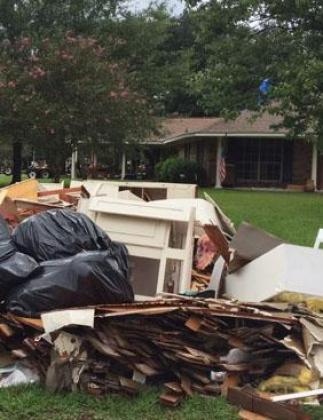
Olivia McClure
Louisiana homeowners who need guidance on cleaning up and making repairs following Hurricane Laura can turn to information from the LSU AgCenter LaHouse Home and Landscape Resource Center.
Claudette Reichel, LSU AgCenter housing specialist, said repairing a damaged home is a daunting and stressful ordeal. It can also be costly, both financially and to health.
“The expense, time and work that go into repairing your home can have a silver lining with clean-up and restoration methods that reward you with a more resilient, healthy, energy-efficient and comfortable home,” she said. “Even when money is tight, there are opportunities to make choices for a better home.”
A “Flood Recovery and Resilience” page is on the AgCenter website at www.LSUAgCenter.com/LaHouse. Scroll down to the Flood Recovery and Resilience link. It includes links to articles and publications on storm recovery and ways to avoid similar damage in the future.
The “Storm Damage Cleanup Highlights” publication, available at bit.ly/lsuagstormcleanup, offers the following guidance:
— Don’t use well water until it has been tested and deemed safe.
— Throw away food as well as wooden and plastic food preparation and storage items that came in contact with floodwater. Sanitize metal and ceramic items.
— Before entering a home that has flooded, carefully assess potential dangers, such as structural damage and snakes. Be sure electrical and gas supplies have been disconnected.
— If your home was built before 1978 — meaning it’s more likely to have lead-based paint and asbestos-containing materials — take proper precautions before gutting walls.
— Determine if damaged furniture is salvageable. Wooden pieces may be restorable if cleaned and allowed to dry. Restoration of upholstered furniture is more difficult; such items should be discarded if they were submerged.
— Remove wet carpet. Solid hardwood and ceramic tile flooring often can be restored; however, it’s best to replace many other types of flooring.
— Have a professional inspect and service appliances and fixtures before use.
—A flood-damaged building requires special attention to avoid or correct a mold population explosion. Follow the 10 steps listed in this fact sheet for safe and effective do-it-yourself mold removal.
Recommendations for removing mold are posted at bit.ly/lsuagmoldremoval. As soon as possible, remove moldy, porous items such as carpeting and gypsum wallboard; clean and disinfect surfaces; and allow all materials to dry thoroughly.
An in-depth page of FAQs is available at bit.ly/lsuagguthome, covering additional topics such as replacing insulation and problems with drying home materials.
While restoring your home, consider “wet floodproofing” it to reduce future damage. This concept refers to making improvements — such as using water-resistant materials, elevating appliances and taking steps to prevent wicking — that make for easier cleanup in the event of a flood. Information on floodproofing is available at bit.ly/lsuagwetfloodproof.
A complete listing of AgCenter publications on disaster recovery can be found at bit.ly/lsuagdisasterrecovery.
